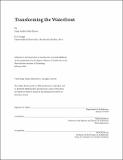| dc.contributor.advisor | Mark Jarzombek. | en_US |
| dc.contributor.author | Silén Rivera, Jorge Andrés | en_US |
| dc.contributor.other | Massachusetts Institute of Technology. Department of Architecture. | en_US |
| dc.date.accessioned | 2018-05-23T15:05:01Z | |
| dc.date.available | 2018-05-23T15:05:01Z | |
| dc.date.copyright | 2018 | en_US |
| dc.date.issued | 2018 | en_US |
| dc.identifier.uri | http://hdl.handle.net/1721.1/115619 | |
| dc.description | Thesis: M. Arch., Massachusetts Institute of Technology, Department of Architecture, 2018. | en_US |
| dc.description | This electronic version was submitted by the student author. The certified thesis is available in the Institute Archives and Special Collections. | en_US |
| dc.description | Cataloged student-submitted from PDF version of thesis. | en_US |
| dc.description | Includes bibliographical references (page 72). | en_US |
| dc.description.abstract | OUR relation with nature develops from an early age. The built environment, the food we eat and the pictures we see nurture and influence our ways of inhabiting the landscape and how that landscape inhabits our imagination and our conception of place. How we experience nature during the course of our lives inevitably shapes our understanding of it. In the Caribbean, the overall colonial history reveals patterns of settlement around the waterfront which function as physical formulations for social segregation and reclusiveness, disregarding public access and mixing. Whether for military purposes, or as a result of an economy heavily based on tourism the urban conditions showcase a deliberate and consistent public inaccessibility to the waterfront consequence of a politically imposed order. The urban logics of San Juan displays the immense distances between the majority of local inhabitants and the privilege few that coexists with the waterfront. The key word here is isolation. An island within an island. The context disappears. An old colonial fortress, a highway, huge apartment complexes, hotels and environmental pollution estrange the inhabitant from its immediate context. A social and cultural understanding of the waterfront emerges and with it a particular subject. In this scheme, the sea is for an outsider, a tourist or anyone who is willing to play or pay for such a role, even as a local. Far from reality, a paradise materializes: the Island of Enchantment where everything else disappears. New coastal challenges broad about by climate change cannot be avoided when proposing an alternate scheme which renders the waterfront accessible. This imposes paradoxical challenges. There is a tension between accessibility to resources and defense, between ecological rehabilitation and existing communities, between canceling out a threatening global phenomena and the definition of a world without exteriority. The project takes advantage of the local particularities of the existing ecological system and utilizes the mangrove forest as a locally produced defense system and a space making opportunity with which to negotiate these tensions. It aims to make visible and accessible a new epistemological space, by incorporating a research center, and incorporating scenarios in which accessibility to resources, in this case fish, can trigger a possible new relationship between the concreteness of the built environment and the construction of an alternative political order. | en_US |
| dc.description.statementofresponsibility | by Jorge Andrés Silén Rivera. | en_US |
| dc.format.extent | 73 pages | en_US |
| dc.language.iso | eng | en_US |
| dc.publisher | Massachusetts Institute of Technology | en_US |
| dc.rights | MIT theses are protected by copyright. They may be viewed, downloaded, or printed from this source but further reproduction or distribution in any format is prohibited without written permission. | en_US |
| dc.rights.uri | http://dspace.mit.edu/handle/1721.1/7582 | en_US |
| dc.subject | Architecture. | en_US |
| dc.title | Transforming the waterfront | en_US |
| dc.type | Thesis | en_US |
| dc.description.degree | M. Arch. | en_US |
| dc.contributor.department | Massachusetts Institute of Technology. Department of Architecture | |
| dc.identifier.oclc | 1036986897 | en_US |
